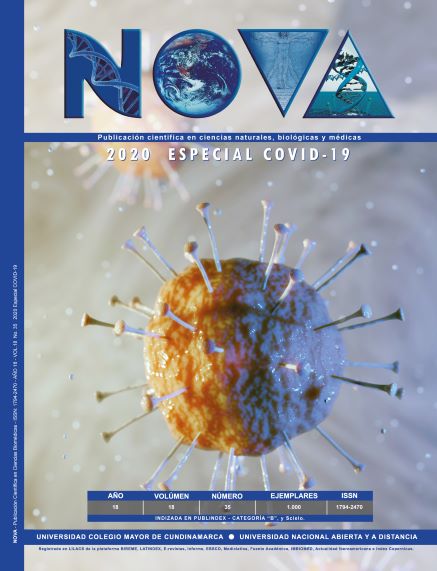Potential Peptide-Based Therapeutic Strategies to Mitigate SARS-COV-2 Infection
Potenciales estrategias terapéuticas basadas en péptidos para mitigar la infección por SARS-CoV-2
NOVA by http://www.unicolmayor.edu.co/publicaciones/index.php/nova is distributed under a license creative commons non comertial-atribution-withoutderive 4.0 international.
Furthermore, the authors keep their property intellectual rights over the articles.
Show authors biography
The new pandemic by SARS-CoV-2 has encouraged the search for therapeutic alternatives that reduce mortality rates; within these, the use of peptides stands out for its ease of synthesis; easy production on a large scale, specificity in the immune response, versatility in dosage, high purity, economy, among others; offering an excellent option to the traditional approach, failing to evaluate its effectiveness, efficiency and safety at clinical level
Article visits 217 | PDF visits 120
Downloads
1. Huang C, Wang Y, Li X, Ren L, Zhao J, Hu Y, et al. Clinical features of patients infected with 2019 novel coronavirus in Wuhan, China. Lancet. 2020;395(10223):497-506.
2. World Health Organization. Coronavirus disease (COVID-2019) situation reports. Situation report—55. 2020 [ciitado el 17 de junio]. Disponible en: https://www.who.int/docs/default-source/coronaviruse/transcripts/who-audio-emergencies-coronavirus-press-conference-full-and-final-11mar2020.pdf?sfvrsn=cb432bb3_2
3. Vankadari N, Wilce JA. Emerging COVID-19 coronavirus: glycan shield and structure prediction of spike glycoprotein and its interaction with human CD26. Emerg Microbes Infect [Internet]. 2020 Jan 1;9(1):601–4. DOI: 10.1080/22221751.2020.1739565
4. Venkatagopalan P, Daskalova SM, Lopez LA, Dolezal KA, Hogue BG. Coronavirus envelope (E) protein remains at the site of assembly. Virology. 2015;478:75–85.
5. Chan JF-W, Kok K-H, Zhu Z, Chu H, To KK-W, Yuan S, et al. Genomic characterization of the 2019 novel human-pathogenic coronavirus isolated from a patient with atypical pneumonia after visiting Wuhan. Emerg Microbes Infect. 2020;9(1):221–36.
6. Li F, Li W, Farzan M, Harrison SC. Structure of SARS coronavirus spike receptor-binding domain complexed with receptor. Science (80). 2005; 309(5742):1864–8.
7. Hoffmann M, Kleine-Weber H, Schroeder S, Krüger N, Herrler T, Erichsen S, et al. SARS-CoV-2 cell entry depends on ACE2 and TMPRSS2 and is blocked by a clinically proven protease inhibitor. Cell. 2020.
8. Dutta K. A novel peptide analogue of spike glycoprotein shows antiviral properties against SARS-CoV-2. 2020. DOI: 10.21203/rs.3.rs-32796/v1
9. Xia S, Liu M, Wang C, Xu W, Lan Q, Feng S, et al. Inhibition of SARS-CoV-2 (previously 2019-nCoV) infection by a highly potent pan-coronavirus fusion inhibitor targeting its spike protein that harbors a high capacity to mediate membrane fusion. Cell Res. 2020;30(4):343–55.
10. Zhang L, Lin D, Sun X, et al. Crystal structure of SARS-CoV-2 main protease provides a basis for design of improved α-ketoamide inhibitors. Science. 2020;368(6489):409-412. doi:10.1126/science.abb3405
11. Pérez Escoda MT. Diseño y síntesis de péptidos para el diagnóstico de la infección por el virus de la hepatitis G (GBV-C/HGV). Universitat de Barcelona; 2007.
12. Purcell AW, McCluskey J, Rossjohn J. More than one reason to rethink the use of peptides in vaccine design. Nat Rev Drug Discov. 2007;6(5):404–14.
13. Pant S, Singh M, Ravichandiran V, Murty USN, Srivastava HK. Peptide-like and small-molecule inhibitors against Covid-19. J Biomol Struct Dyn. 2020;1–10.
14. Abdelmageed MI, Abdelmoneim AH, Mustafa MI, Elfadol NM, Murshed NS, Shantier SW, et al. Design of a Multiepitope-Based Peptide Vaccine against the E Protein of Human COVID-19: An Immunoinformatics Approach. Biomed Res Int. 2020.
15. World Health Organization. Proyecto de panorama de las vacunas candidatas COVID-19 [Internet]. 2020 [citado el 17 de junio]. Disponible en: https://www.who.int/publications/m/item/draft-landscape-of-covid-19-candidate-vaccines






